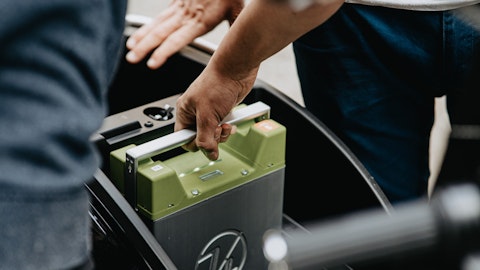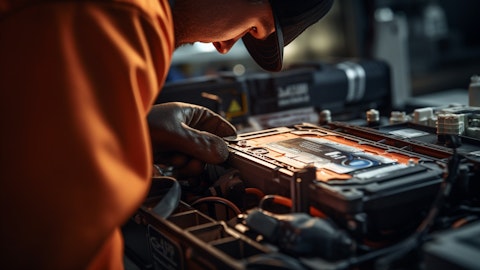Raj Talluri: Yes, that is what after we deliver the samples from, in April from our factory, right? I mean, what we have done previously has really helped them understand our technology and how it works and so on. But the product that’s actually, targeted to go into the cell phone is a thousand cycles fast charging product, which is one we want to sample in April. And that’s when, you can think of the clock starting. Now, typically my experience in these kind of things, is that we will get to a model that we are going to be in, there will be technology evaluation where they are just evaluating the battery in isolation in terms of the test and so on. Then they will actually pass that. Then they will actually put it in an actual phone model and that will go on for some time.
And then the precise phone it will go into, is the one that happens next. So that’s the total period of nine to 12 months. The actual design win of what model we are in will come just a, few months before high volume typically doesn’t, they don’t decide way ahead. But the good news, is once you pass the technology qualification, once you are in the, in their vendor list, subsequent models can come much faster. Because you’re now inside, right? And that’s what my experience has been, previously with memories and process. The first one takes a little longer. Once we get in, follow on models can come faster.
Chris Souther: Understood. And then maybe just on the route shade contribution in the fourth quarter, can you update us on what the run rate is for that legacy business? It seemed a little bit, stronger than I had been expecting at least?
Farhan Ahmad: Yes, no, I can talk about that. So in the fourth quarter, Routejade business tends to be stronger. There is normally a seasonality associated with it. So – for the year, the seasonality is that the second quarter is kind of the low point. The fourth quarter is the strong point, generally speaking. This year in ’20, what we saw was that there was a bunch of business that was at the end of the year and beginning of ’24, so end of ’23, beginning of 24. And a lot of that got shipped in ’23. So that was a factor where the revenue came in stronger. And also like, quarter-on-quarter decline, also it contributed to it. So generally speaking, for the first three quarters, you should think of it as about $18 million annualized run rate and then fourth quarter stronger. So and with – like in the fourth quarter of ’23 being somewhat exceptionally stronger.
Operator: Our next question comes from Tim Moore with EF Hutton. Please unmute your audio and ask your question.
Tim Moore: Thanks. And most of my questions were already answered. But regarding, you mentioned the 90% yield goal commentary two questions ago. Can you maybe give us, a rough, better sense, and we won’t hold to, hold you to it, of the timing roadmap, maybe for potential revenues run rate? And when you look out to maybe the December quarter, or the March quarter next year from the Fab2 sample production. If that goes pretty well, any rough thoughts on maybe what the revenue ties of that could be, a year from now quarterly?
Ajay Marathe: As Raj. Yes, go ahead, Farhan.
Farhan Ahmad: No, I was just saying that, we’re guiding one quarter at a time. And so, we’ll get to it when we get to it. But we kind of talked about the timing of the production ramp and we talked about, we gave you some good color on that. And we have given like, ’25 that we will be in smartphones and so you will have a revenue ramp associated with that. I don’t know Raj.
Raj Talluri: Yes, I mean, absolutely. I mean, look, we’re going to sample products from our Fab2 in April. And we hopefully there will be some IoT type customers that can go to production earlier in ’24, but the smartphone ones will really be in ’25. So yes, I think that’s just the way you guys should be thinking about this. And again, super excited by the technology and acceptance, the customer base. Once we qualify, it’s just going to be a lot more fun.
Tim Moore: That’s good. Yes, I think you were pretty clear on the 2025 timing for the smartphones, but the IoT, that could be pretty promising, maybe towards the end of the year. The other question I have is on smartphones. I mean, I mentioned it was a sum total of parameters and there’s trade-offs. If you get asked during qualifications and maybe pilots, do you think you could get asked to do an exclusive contract, for a major OEM customer? I think you do the unique specification exclusively for them, or is that something you wouldn’t consider?
Raj Talluri: Yes, I mean, look, it’s just a business case, right? I mean, so if there’s guaranteed volumes and good ASP, we’re totally open to it. But by the way, the nature of this business, is that what I expect to happen is that, we’ll probably, sign some joint development agreements, or something like that. And then they’ll talk about, what size battery they want, what size battery we make, what time is the yield, and that’s how these things go typically from my experience. But in some way, it will become a little bit exclusive because of the shape of the battery, not the technology itself, right?
Tim Moore: Okay, that makes sense. Well, thanks, and good luck with the April sampling, and that’s it for my questions.
Raj Talluri: Thank you.
Operator: There are no further questions at this time. With that, I’d like to turn it over to Dr. Raj Talluri for closing remarks.
Raj Talluri: Yes, thank you all. Been a really great year in ’23 recap, super excited by where we are on ’24. So, look forward to talking to you guys next quarter. Thank you for all your interest.
Follow Enovix Corp (NASDAQ:ENVX)
Follow Enovix Corp (NASDAQ:ENVX)
Receive real-time insider trading and news alerts





